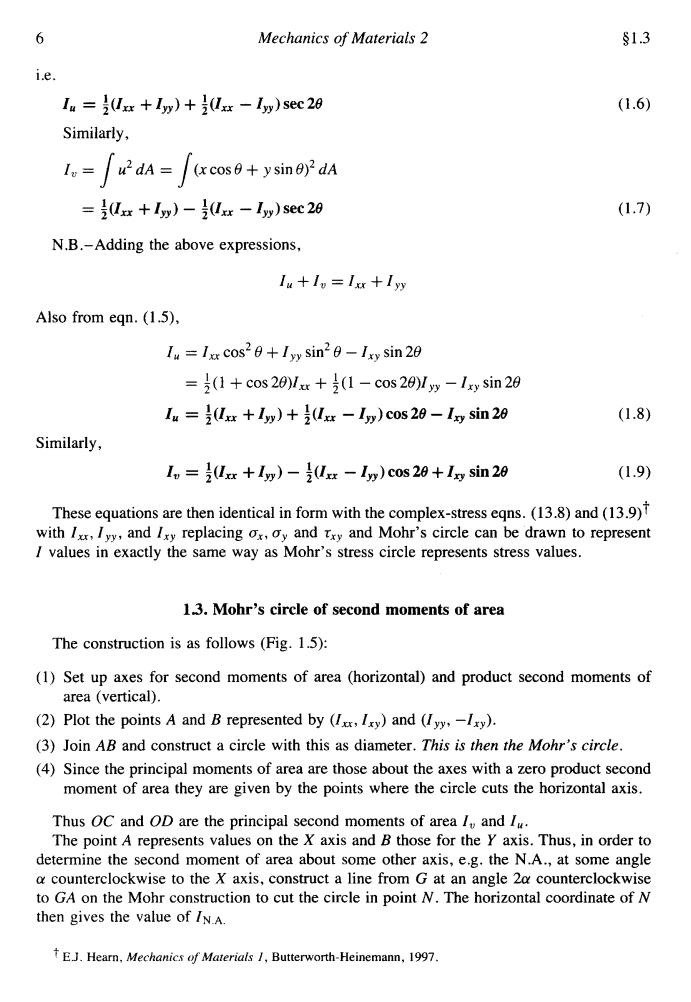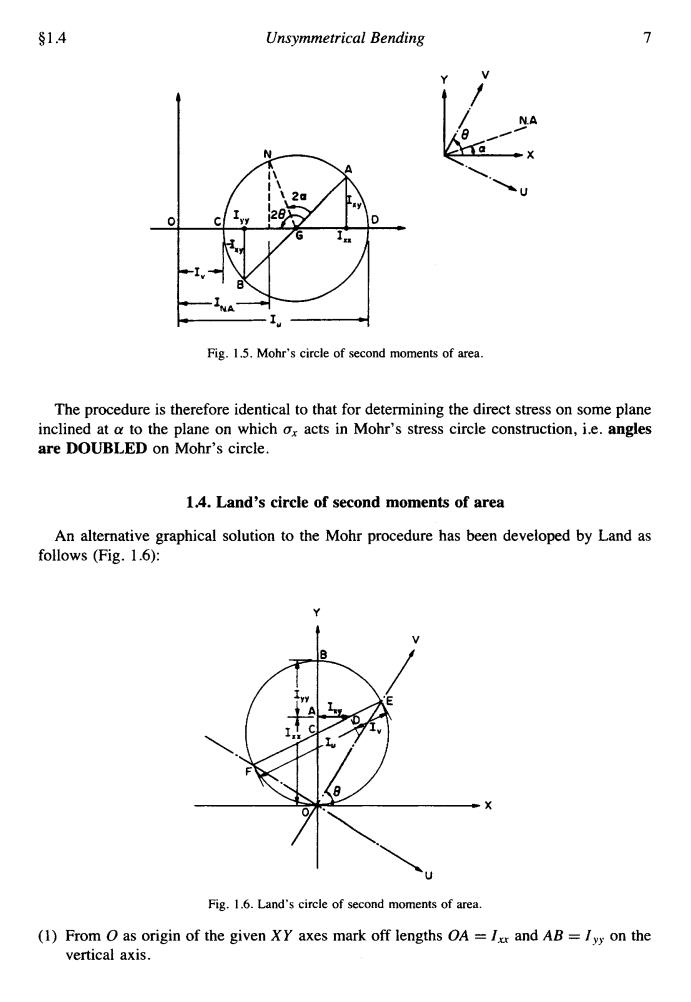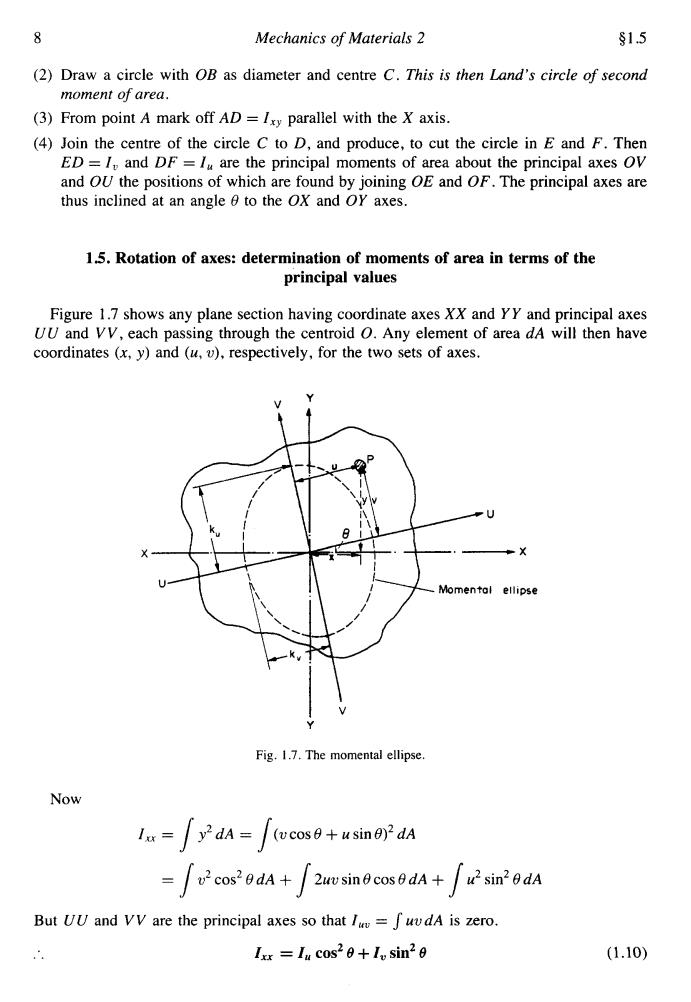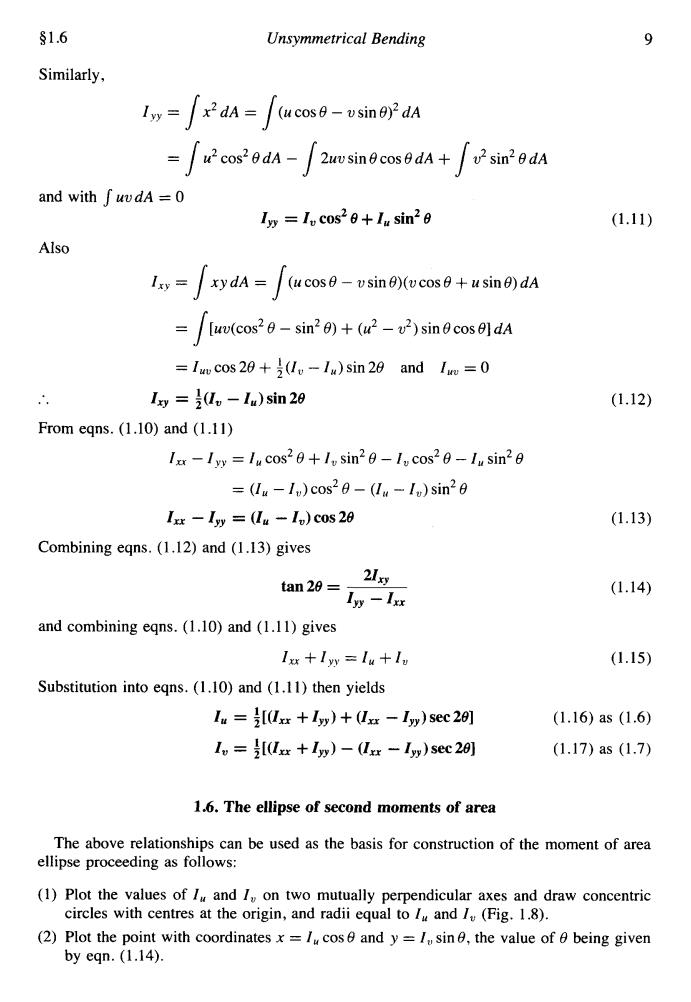
6 Mechanics of Materials 2 §1.3 i.e. Iu =(Ixx +Iyy)+(Ix-Iyy)sec 20 (1.6) Similarly, 1.=da=coso+ysineydA =(Ixx +Iy)-(Itx -Iyy)sec 20 (1. 7 N.B.-Adding the above expressions, Iu+1=Ix+lyy Also from eqn.(1.5), Iu=Ixt cos20+Iyy sin20-Ixy sin 20 =(1 cos 20)/xx+(1-cos 20)lyy-Ixy sin 20 Iu=(Ixx Iyy)+(Ixx -Iyy)cos 20-Ixy sin 20 (1.8) Similarly, I=(Ixx Iy)-(Itz -Iyp)cos 20+Igy sin 20 (1.9) These equations are then identical in form with the complex-stress eqns.(13.8)and(13.9) with I lyy,and Iy replacing ox,oy and txy and Mohr's circle can be drawn to represent I values in exactly the same way as Mohr's stress circle represents stress values. 1.3.Mohr's circle of second moments of area The construction is as follows (Fig.1.5): (1)Set up axes for second moments of area (horizontal)and product second moments of area (vertical). (2)Plot the points A and B represented by (,I)and (Iyy,-I). (3)Join AB and construct a circle with this as diameter.This is then the Mohr's circle (4)Since the principal moments of area are those about the axes with a zero product second moment of area they are given by the points where the circle cuts the horizontal axis. Thus OC and OD are the principal second moments of area I and I. The point A represents values on the X axis and B those for the Y axis.Thus,in order to determine the second moment of area about some other axis,e.g.the N.A.,at some angle a counterclockwise to the X axis,construct a line from G at an angle 2a counterclockwise to GA on the Mohr construction to cut the circle in point N.The horizontal coordinate of N then gives the value of IN.A. EJ.Hearn,Mechanics of Materials 1,Butterworth-Heinemann,1997
6 Mechanics of Materials 2 i.e. 1 1, = TUxx +zYy> + Similarly, - 1,,)sec20 $1.3 (1.6) I, = u2dA = (xcos8+ysin8)2dA JJ 1 = z(zxx + zyy) - ;(L - zyy) sec 28 N.B .-Adding the above expressions, I, +I, = I,, + I,, Also from eqn. (1 S), I, = I, cos2 8 + I,, sin2 8 - I,, sin 20 = (1 + cos B)I, + (1 - cos 20)1,, - I,, sin 28 Z, = ;(z~ +I,,)+ ;(zxx -Z,.~)COS~O-Z~S~~~~ (1.8) Similarly, I,, = ;(zXx + zYy) - ;(zX, - zYy) cos 28 + z, sin 28 (1.9) These equations are then identical in form with the complex-stress eqns. (1 3 .S) and (1 3.9)t with I,, I,,, and I,, replacing a,, oy and txy and Mohr’s circle can be drawn to represent I values in exactly the same way as Mohr’s stress circle represents stress values. 13. Mohr’s circle of second moments of area The construction is as follows (Fig. 1.5): (1) Set up axes for second moments of area (horizontal) and product second moments of (2) Plot the points A and B represented by (I,, I,,) and (I,,, -Ixy). (3) Join AB and construct a circle with this as diameter. This is then the Mohr’s circle. (4) Since the principal moments of area are those about the axes with a zero product second area (vertical). moment of area they are given by the points where the circle cuts the horizontal axis. Thus OC and OD are the principal second moments of area I, and I,. The point A represents values on the X axis and B those for the Y axis. Thus, in order to determine the second moment of area about some other axis, e.g. the N.A., at some angle a! counterclockwise to the X axis, construct a line from G at an angle 2a! counterclockwise to GA on the Mohr construction to cut the circle in point N. The horizontal coordinate of N then gives the value of IN.A. t E.J. Hem, Mechanics ofMuteriuls I, Butterworth-Heinemann, 1997

§1.4 Unsymmetrical Bending 7 2a D Fig.1.5.Mohr's circle of second moments of area. The procedure is therefore identical to that for determining the direct stress on some plane inclined at a to the plane on which ox acts in Mohr's stress circle construction,i.e.angles are DOUBLED on Mohr's circle. 1.4.Land's circle of second moments of area An alternative graphical solution to the Mohr procedure has been developed by Land as follows (Fig.1.6): 0 Fig.1.6.Land's circle of second moments of area. (1)From O as origin of the given XY axes mark off lengths OA =I and AB =lyy on the vertical axis
$1.4 Unsymmetrical Bending YV 7 Fig. 1.5. Mohr's circle of second moments of area. The procedure is therefore identical to that for determining the direct stress on some plane inclined at CY to the plane on which uX acts in Mohr's stress circle construction, i.e. angles are DOUBLED on Mohr's circle. 1.4. Land's circle of second moments of area An alternative graphical solution to the Mohr procedure has been developed by Land as follows (Fig. 1.6): Y t V Fig. 1.6. Land's circle of second moments of area. (1) From 0 as origin of the given XY axes mark off lengths OA = I, and AB = I,, on the vertical axis

8 Mechanics of Materials 2 §15 (2)Draw a circle with OB as diameter and centre C.This is then Land's circle of second moment of area. (3)From point A mark off AD=Ixy parallel with the X axis. (4)Join the centre of the circle C to D,and produce,to cut the circle in E and F.Then ED=I and DF=I are the principal moments of area about the principal axes OV and OU the positions of which are found by joining OE and OF.The principal axes are thus inclined at an angle 0 to the OX and OY axes. 1.5.Rotation of axes:determination of moments of area in terms of the principal values Figure 1.7 shows any plane section having coordinate axes XX and YY and principal axes UU and VV,each passing through the centroid O.Any element of area dA will then have coordinates (x,y)and (u,v),respectively,for the two sets of axes. X Momental ellipse Fig.1.7.The momental ellipse. Now y dsin dA -cosdA+2usinecosdA+sinodA But UU and VV are the principal axes so thatI=fuvdA is zero. Ixx Iu cos20+Iv sin20 (1.10)
8 Mechanics of Materials 2 $1.5 (2) Draw a circle with OB as diameter and centre C. This is then Land's circle of second (3) From point A mark off AD = I,, parallel with the X axis. (4) Join the centre of the circle C to D, and produce, to cut the circle in E and F. Then ED = I, and DF = I, are the principal moments of area about the principal axes OV and OU the positions of which are found by joining OE and OF. The principal axes are thus inclined at an angle 8 to the OX and OY axes. moment of area. 15. Rotation of axes: determination of moments of area in terms of the principal values Figure 1.7 shows any plane section having coordinate axes XX and Y Y and principal axes UU and VV, each passing through the centroid 0. Any element of area dA will then have coordinates (x, y) and (u, v), respectively, for the two sets of axes. I" Y Fig. I .7. The momental ellipse. Now 1, = /y2dA = /(vcos8+usin8)2dA = /u2cos28dA+ J~uvsin~cos~dA+ s u2sin28dA But UU and VV are the principal axes so that I,, = SuvdA is zero. .. zXx = I, cos2 8 + Z, sin' e (1.10)

§1.6 Unsymmetrical Bending 9 Similarly, Idn=f(ucoso-vsinoydn cdA-sincdA+sindA and with∫uvdA=0 Iyy Iv cos2+In sin20 (1.11) Also I,=∫xydA=∫-sins8+usin))dA =/[uu(cos20-sin20)+(u2)sin0cos 0ldA =Iuv cos 20+(-I)sin 20 and Iie =0 Ixy=(I-Iu)sin 20 (1.12 From eqns.(1.10)and (1.11) Ixx -Iyy Iu cos20+1 sin20-I cos20-Iu sin20 =(Iu-1,)cos20-(Iw-1)sin20 Ixx -Iyy (Iu -I)cos 26 (1.13) Combining eqns.(1.12)and (1.13)gives 2Ix tan20=Iyy -Ixx (1.14) and combining eqns.(1.10)and (1.11)gives Ix +Iyy=lu+lv (1.15) Substitution into egns.(1.10)and (1.11)then yields Iu =(Ix +I)+(Ixz -Iy)sec 20] (1.16)as(1.6) I=[(I +lyy)-(Itx-Iyy)sec20] (1.17)as(1.7) 1.6.The ellipse of second moments of area The above relationships can be used as the basis for construction of the moment of area ellipse proceeding as follows: (1)Plot the values of I and I.on two mutually perpendicular axes and draw concentric circles with centres at the origin,and radii equal to I and I(Fig.1.8). (2)Plot the point with coordinatesx =l cos and y =I sin,the value of 0 being given by eqn.(1.14)
$1.6 Unsymmetrical Bending 9 Similarly, I,, = /x2dA = /(ucos6 - wsinQ2dA = /u2cos26dA - 2uvsin6cos6dA+ and with S uvdA = 0 zYy = I,, cos2 e + I, sin2 e Also I,, = /xydA = /(ucos8- wsin8)(vcos6+usin6)dA (1.11) = J [uw(cos2 8 - sin2 6) + (u2 - w2) sin 6 cos 61 dA (1.12) = I,, cos 26 + :(I, - I,) sin 26 and I,, = 0 .. Zxy = z(Z. 1 - Z,)sin28 From eqns. (1.10) and (1.11) I,, - I,, = I, cos2 6 + I, sin2 8 - I, cos2 6 - I, sin2 6 = (I, - 1,) cos2 0 - (I, - I,) sin2 8 z, - iyy = (I, - 1.1 COS 28 (1.13) Combining eqns. ( 1 .12) and (1 .13) gives (1.14) and combining eqns. (1 .lo) and (1.1 1) gives I, + I,, = I, + I, (1.15) Substitution into eqns. (1.10) and (1.11) then yields 1, = [(zXx + + (zXx - zYy) sec 281 (1.16) as (1.6) 1. = $ [(L + zYy) - (zXx - zYy ) sec 281 (1.17) as (1.7) 1.6. The ellipse of second moments of area The above relationships can be used as the basis for construction of the moment of area ellipse proceeding as follows: (1) Plot the values of I, and I, on two mutually perpendicular axes and draw concentric (2) Plot the point with coordinates x = I, cos 6 and y = I,, sin 6, the value of 6 being given circles with centres at the origin, and radii equal to I, and I, (Fig. 1.8). by eqn. (1.14)